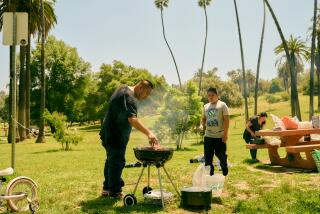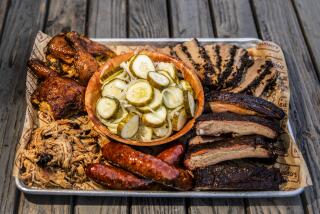Hot Stuff
- Share via
Introducing . . . the $7,000 hamburger.
That’s $5 for the patty and condiments--and $6,995 for the barbecue to cook it on.
In yet another sign that society has completely lost its mind, the simple backyard grill has orbited into the stratosphere of $250 Montblanc pens, $14,000 Rolex watches and $133,000 Mercedes-Benzes.
Built from surgical-quality stainless steel, equipped with remote controls and able to do everything but flip its own burgers, the luxury gas barbecue is the latest toy for people who have money to charbroil.
It’s also a booming little business juggernaut. Dozens of companies are rolling out pricey Space-Age cooking contraptions that go from “zero to 500 degrees in just five minutes” and spit out 400 burgers per hour.
Even Weber, the longtime champion of basic charcoal grills, has invested millions to debut a line of $1,500 and $3,000 cookers.
It defies logic, admits Weber Vice President Jim Forbes: In theory, less than 1% of U.S. households have enough disposable income to afford these things, “but what we’re seeing is people saving for them the way they save for luxury cars.”
Then again, recent scientific studies of the male brain have uncovered--in the temporal lobe that controls the drive for sex, food and loud plaid golf pants--the source of what is known in medical literature as “compulsive barbecue disorder.”
OK. We lied about that. But ever since primitive man first used fire and sticks to grill a brontosaurus burger, the search has been on for the ultimate barbecue.
In modern times, this quest for the holy grill surfaced in the 1920s, when auto maker Henry Ford invented the compressed charcoal briquette as a way to make money off scrap wood left over from building cars.
After World War II, suburban chefs created barbecues out of oil drums or bricks. Then, in 1948, Hasty-Bake introduced the portable backyard broiler, which was later put on display at the Chicago Museum of Science and Industry and at the 1958 World’s Fair in Brussels. A few years later, Weber debuted its famous three-legged kettle.
The first gas grill arrived in 1960, but its luxury offspring didn’t pick up steam (or perhaps smoke) until about three years ago, says Ann Spehar of the Barbecue Industry Assn., based outside Chicago.
The man behind the trend, Surjit Kalsi, a gas-appliance engineer from India, took his idea for a $3,000 grill to a barbecue distributor in 1991, only to be told he was a lunatic.
“They said I wouldn’t sell even one unit a year,” Kalsi recalls.
Today, his Los Alamitos-based Dynamic Cooking Systems Inc. is barely able to keep up with demand. And last year, the company sold $11-million worth of high-end outdoor ranges, a tenfold jump from 1991.
DCS recognized that well-heeled baby boomers were willing to plunk down serious cash for durable, restaurant-caliber cooking equipment, says Joe Stombaugh of Commerce-based Lynx, which just introduced a $4,795 barbecue with monster 25,000-BTU red-brass burners under the hood.
*
In a sense, luxury grills have become the outdoor equivalent of surround-sound stereo and TV home entertainment centers, says Tom Caulfield of DCS.
Loaded with such features as state-of-the-art wood-smoke systems, flavor-enhancing lava rocks and multi-spark ignition devices, these backyard beauties broil, steam, wok, rotisserize, deep-fry, bake and everything else short of slaughtering the cow.
Many are also built into custom or prefab “islands,” with tile counter tops, sinks, umbrella stands, heat lamps, electrical outlets, stainless steel cupboards and, occasionally, inlaid backgammon boards--all of which can drive the price tag up to $7,000.
Or more.
Frank J. De Santis Jr. of Shadow Hills sank $30,000 into his backyard cooking center, which includes a dishwasher, oven, garbage disposal, trash compactor and telephone.
“It’s the king of grills,” says De Santis, a housing developer who cooks outdoors once a week and got tired of portable barbecues that “fell apart, were hard to clean and rusted away.”
“With stainless steel, you just hose it off and brush it down. It doesn’t corrode, the wind can’t blow it over, earthquakes won’t knock it down. I’ve had it outside five years and it still looks brand new.”
Although the market for such extravagant grills might seem limited, all sorts of companies are nevertheless scrambling to get in on it--from retailer Williams-Sonoma, whose latest catalog offers a $4,300 cooker, to Weber, which plans to spend virtually all of its 1997 advertising budget promoting expensive models.
*
Does such money really buy a better burger?
Jules Lehr, a barbecue salesman at Paykel Fireplace Fixtures in Santa Monica, is doubtful. “You get the same flavor [with a cheaper grill],” he concedes.
But he adds that luxury barbecues do have advantages over conventional “three-and-out” grills. “I call them three-and-outs because you own ‘em three years and then you have to throw ‘em out,” he says of most low-cost cookers.
The ultra-expensive grills, in contrast, frequently come with lifetime warranties. And they’re a snap to use, Lehr says, stoking up his sales pitch.
One model, the $899 High-Tech Touchlite, even includes a remote control unit that turns the grill on and off, adjusts the temperature and programs the cooking timer. The Touchlite also has a flame sensor that automatically relights any burner that is blown out by wind.
“Every year, there are more bells and whistles,” Spehar says.
Some examples:
* Infrared heating elements. Located at the back of the grill, they cook rotisserie meat from behind, not underneath, so no juices fall into the flame and cause flare-ups. “There’s no way the meat can be burnt,” Lehr says.
* Side burners. These are standard kitchen-style stove burners that can be used to heat sauces, cook beans, boil corn, etc. The idea is to turn the barbecue into a complete outdoor kitchen range.
* Electronic ignition. It’s a battery-powered flame-starter that eliminates the need for matches. Another system is the rotary igniter, which throws multiple sparks at the gas burners.
* Flavor grids. These are sheets of perforated metal between the burners and grill. When meat juice falls onto the hot grid, it vaporizes into the smoke that gives meat its barbecue flavor. Some units use lava rocks or ceramic briquettes instead.
Looking to the future, Stombaugh and other grill-seekers expect 21st century barbecues to feature such accouterments as warming drawers, mini-refrigerators and interior grill lights for nighttime cooking.
Also ahead, presumably, are bigger and better burners.
But for sheer cooking power, there’s still one ultimate barbecue that nobody has been able to touch. In the Old Testament’s Book of Kings, the prophet Elijah butchers a young bull, lays the meat across a pile of wood and stone, then surrounds the arrangement with four jars of water.
Working without such conveniences as multi-spark ignition systems and remote-control programmable timers, he then calls upon God to light the holy barbecue. As recounted in the Bible, “The Lord’s fire came down and burned up the [bull], wood, stones and dust, and it lapped up the water.”
Now that’s a luxury barbecue.
More to Read
Eat your way across L.A.
Get our weekly Tasting Notes newsletter for reviews, news and more.
You may occasionally receive promotional content from the Los Angeles Times.










